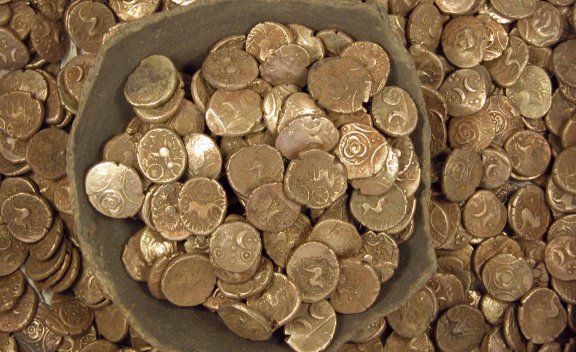The Wickham Market Treasure Trove is a trove of 840 Iron Age gold staters discovered in March 2008 by auto technician Michael Dark using a metal detector in a field on Dallinghoo near Wickham Market, Suffolk, England. 825 coins were discovered at the site during excavation, and 840 coins had been discovered by the time the treasure trove was officially recognized as a treasure trove. The coins were made between 40 B.C. and 15 A.D.

The hoard of gold coins from the British Iron Age has been called “the largest hoard of British Iron Age gold coins to be fully studied,” and it was significant in shedding light on “a great deal of new information about the Iron Age, and especially about East Anglia at the end of the Iron Age.” Since the Waddon-Chase Iron Age burial in 1849, this was the greatest cache of staters discovered.
The trove was purchased by the Ipswich Museum for £316,000 in June 2011.
After 25 years of looking for metals in the fields around Wickham Market, a sixty-year-old auto technician named Michael Darke, who at first requested anonymity, discovered his first gold coin on March 16, 2008. Through the use of the Internet, Darke determined the coin to be a Freckenham stater, so named from the trove in which the typeface was first discovered in 1885.
Darke discovered eight more gold staters a week later, despite the snowfall from his earlier visit to the field and working in the wet snow. He continued to look, and after a while he said that his metal detector “suddenly went crazy” and that he “knew for a fact that he was standing right on a jug of gold.”

He placed stones to mark the location and then made the decision to wait until the following night to retrieve the coins. He gave the justification that the coins had “waited two thousand years for me to find them, so they can wait another night for me.” He unearthed another 774 coins with a shovel.
The soil in the field was clay-like and hadn’t been plowed since 1980, but prior agricultural operations had spread the coins over a 5–10 m (16–33 ft) area when the top of the black clay pot in which they were buried cracked. The majority of the coins were discovered 6-8 inches (15-20 cm) underneath, but some were still inside the broken pot.
Darke delivered the landowner the coins after washing them in warm water, and the landowner then informed the Suffolk County Council Archaeological Service about the discovery.
Since 450 to 800 and 2,000 Iron Age gold staters were discovered by an agricultural worker in a field on the Waddon Chase near Milton Keynes in 1849, the treasure had the most Iron Age gold staters ever discovered.

Although the reason for the wealth’s burial is unknown, there are a number of possibilities. One of the beliefs holds that the treasure was a vow treasure or common treasure that was “collected and buried for the good of the community,” either as a war chest in case of an imminent threat or as payment of tribute to ward off an invasion.
“The discovery is important because it underscores the likely political, economic, and religious importance of the area,” according to Jude Pluviez of Suffolk County Council’s Archaeological Service. This specific find also provided “much new information about the Iron Age, and especially about East Anglia in the late Iron Age.”
This is the largest collection of British Iron Age gold coins to have been thoroughly investigated, according to Ian Lanes, the British Museum’s then-Iron Age coin curator.





